Carnegie Learning Algebra II Student Skills Practice 1st Edition Chapter 2 Exercise 2.3 Skills Practice Page 283 Problem 1 Answer
We are given the parent quadratic function asf(x)=x2 and its transformation asy=4x2 and state if the transformation is a vertical stretch or vertical compression.
Then, we have to state if the graph includes a reflection or not.
We will graph each function on the same coordinate plane and then we can easily visualize the transformations taking place.
So, we have the graphs of the functions f and g as follows:
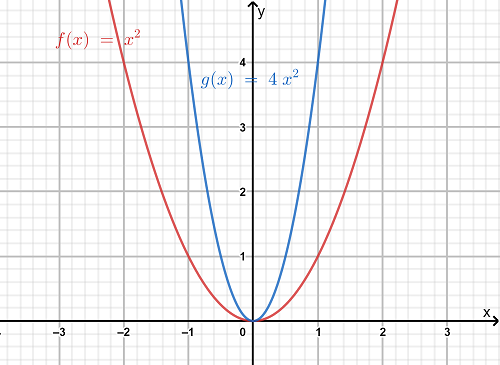
So, we observe from the graph that the function g is more steeper than the function f.
Hence, the transformation is a vertical compression of the graph off(x)=x2.
Also, as both the graphs lie on the same side in the above graph, so there is no reflection included in the graph.
The graph of the functionsf(x)=x2 andg(x)=4 x2 is obtained as:
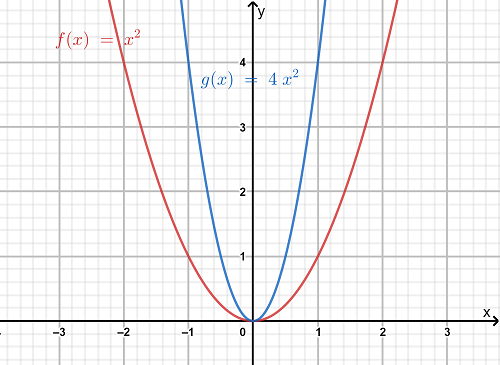
The transformation is a vertical compression and there is no reflection included in the graph.
Carnegie Learning Algebra II Chapter 2 Exercise 2.3 solutions
Page 283 Problem 2 Answer
We are given the parent quadratic function asf(x)=x2 and its transformation as g(x)=1/8x2 and state if the transformation is a vertical stretch or vertical compression.
Then, we have to state if the graph includes a reflection or not.
We will graph each function on the same coordinate plane and then we can easily visualize the transformations taking place.
So, we have the graph of the functions f and p as follows:
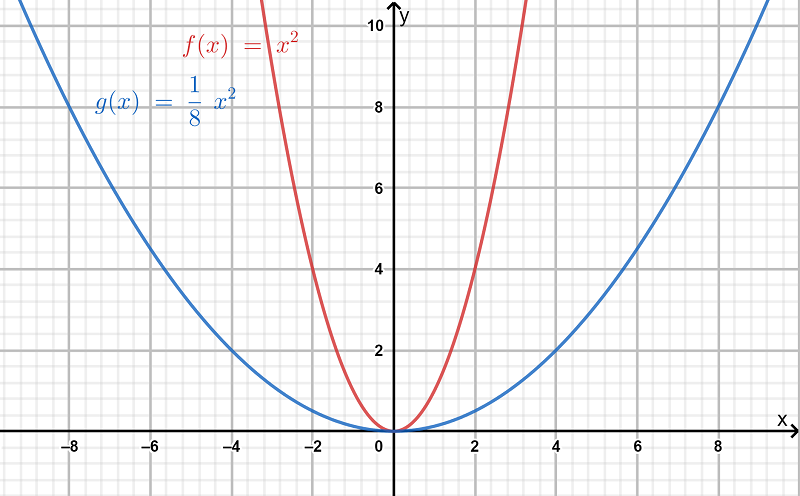
So, we observe from the graph that the function p is more wide than the function f.
Hence, the transformation is a vertical stretch of the graph off.

Also, from the given function, we have a=1/8.
So, the factor of stretch is 8.
Next, as both the graphs lie on the same side in the above graph, so there is no reflection included in the graph.
The graph of the functions f(x)=x2 and g(x)=1/8 x2 is obtained as follow
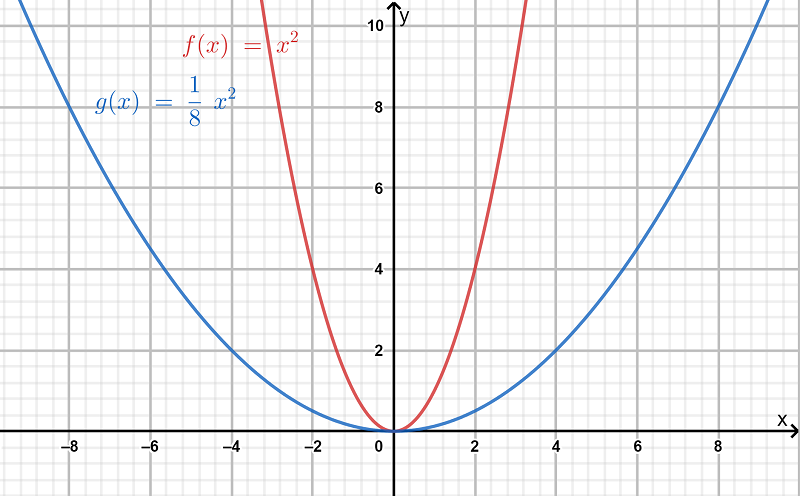
The transformation is a vertical stretch by a factor of 8 and there is no reflection included in the graph.
Page 284 Problem 3 Answer
We are given the parent quadratic function as f(x)=x2 and its transformation as g(x)=−5x2 and state if the transformation is a vertical stretch or vertical compression.
Then, we have to state if the graph includes a reflection or not.
We will graph each function on the same coordinate plane and then we can easily visualize the transformations taking place.
So, we have the graph of the given functions as follows:
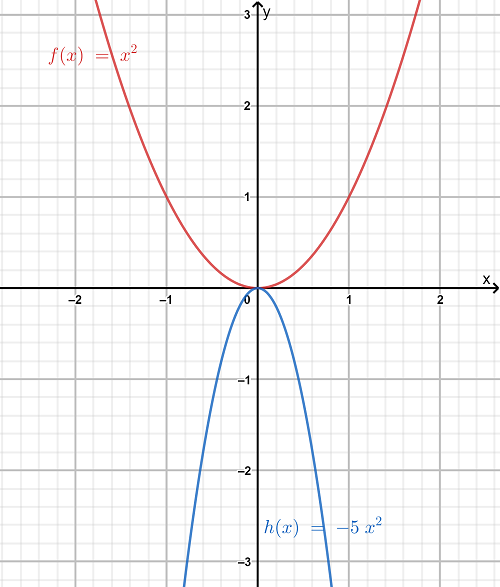
So, we observe from the graph that the function h is more steeper than the functionf.
Hence, the transformation is a vertical compression of the graph off by a factor of 5 as a=5.
Also, as both the graphs lie on the opposite side in the above graph, so there is reflection included in the graph.
The graph of the functions f(x)=x2 and g(x)=−5x2 is obtained as follows:

The transformation is a vertical compression by a factor of 5 along with a reflection about x-axis.
Carnegie Learning Algebra II Student Skills Practice 1st Edition Chapter 2 Exercise 2.3 Skills Practice Page 284 Problem 4 Answer
We are given the parent quadratic function as f(x)=x2 and its transformation as m(x)=2.5x2 and state if the transformation is a vertical stretch or vertical compression.
Then, we have to state if the graph includes a reflection or not.
We will graph each function on the same coordinate plane and then we can easily visualize the transformations taking place.
So, we have the graphs of the functions as follows:

So, we observe from the graph that the function m is more steeper than the function f.
Hence, the transformation is a vertical compression of the graph off by a factor of 2.5 as a=2.5.
Also, as both the graphs lie on the same side in the above graph, so there is no reflection included in the graph.
The graphs of the functionsf(x)=x2 andm(x)=2.5x2 is obtained as follows:

The transformation is a vertical compression by a factor of 2.5 and there is no reflection included in the graph.
Skills Practice Exercise 2.3 answers
Page 284 Problem 5 Answer
We are given the parent quadratic function asf(x)=x2 and its transformation as d(x)=2/5x2 and state if the transformation is a vertical stretch or vertical compression.
Then, we have to state if the graph includes a reflection or not.
We will graph each function on the same coordinate plane and then we can easily visualize the transformations taking place.
So, we have the graphs of both the functions as follows:
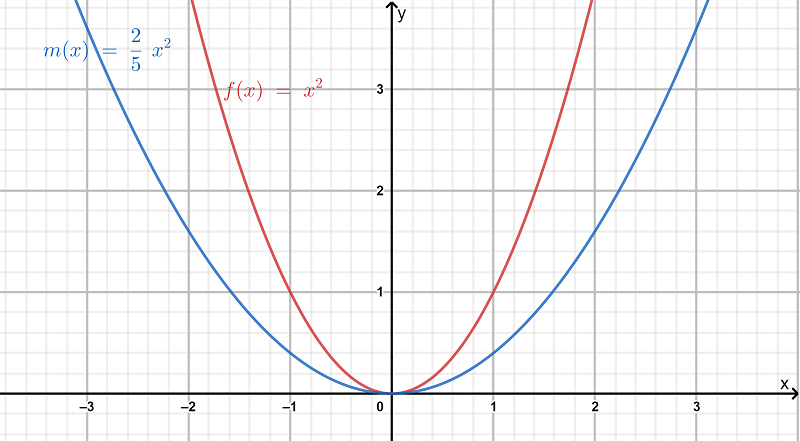
So, we observe from the graph that the function dis more wide than the function f.
Hence, the transformation is a vertical stretch of the graph off by a factor of 2/5 as a=2/5.
Also, as both the graphs lie on the same side in the above graph, so there is no reflection included in the graph.
The graphs of the functions f(x)=x2 and d(x)=2/5x2 is obtained as follows:
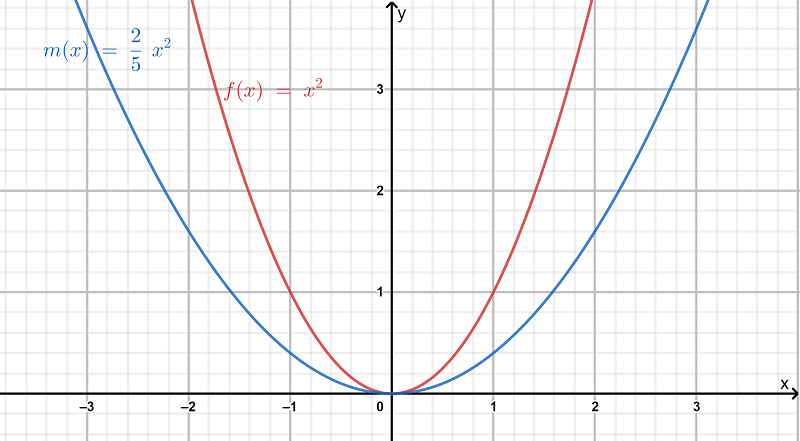
The transformation is a vertical stretch by a factor of 2/5 and there is no reflection included in the graph.
Carnegie Learning Algebra II Student Skills Practice 1st Edition Chapter 2 Exercise 2.3 Skills Practice Page 284 Problem 6 Answer
We are given the parent quadratic function as f(x)=x2 and its transformation as (x)=−1/2x3−3 and state if the transformation is a vertical stretch or vertical compression.
Then, we have to state if the graph includes a reflection or not.
We will graph each function on the same coordinate plane and then we can easily visualize the transformations taking place.
So, we have the graphs of the functions as follows:

So, we observe from the graph that the functiong is more wide than the functionf.
Hence, the transformation is a vertical stretch of the graph off by a factor of 1/2 as a=1/2.
Also, as both the graphs lie on the opposite side in the above graph, so there is reflection included in the graph.
The graph of the functionsf(x)=x2 and g(x)=−1/2x2−3 is obtained as follows:

The transformation is a vertical stretch by a factor of 1/2 and there is no reflection included in the graph.
Page 285 Problem 7 Answer
Here, we are given the parent function as f(x)=x2 and its transformation as g(x)=−4(f(x+3)).
We have to describe how the function g compares to f.
Then we have to use the coordinate notation to represent the transformation from f to g, according to the values of A,C and D So we will compare the given function g with the general transformation given as g(x)=A f(B(x−C))+D and determine the values of A,C and D.
So we have a function g as follows:
⇒g(x)=−4(f(x+3)).
Comparing with the general transformation function g(x)=A f(B(x−C))+D we get A=−4,B=1,C=−3 and D=0.
Hence, as per the value of A there will be a vertical compression by a factor of 2 along with a reflection of g as compared to the function f.
Again, as per the value of D there will be a vertical translation of 0 the unit below the function f.
Thus, the vertex will shift 0 unit below to the point given as (0,0).
The coordinate notation for the transformation from f(x) to g(x) is given as follows:(x,y)→(x,−4y+0).
The graph g(x) is a vertical compression by a factor of 2 followed by a reflection and then a vertical translation unit 0 above to (0,0).
The coordinate nation to represent the transformation fromf(x) to g(x)
is given by (x,y)→(x,−4y+0).
Algebra II Chapter 2 Skills Practice solutions Exercise 2.3
Carnegie Learning Algebra II Student Skills Practice 1st Edition Chapter 2 Exercise 2.3 Skills Practice Page 285 Problem 8 Answer
Here we are given the parent function asf(x)=x2 and its transformation as g(x)=1/3f(x−6)−3
We have to describe how the function g compares to f.
Then we have to use the coordinate notation to represent the transformation from f to g, according to the values of A, C and D
So, we will compare the given function g with the general transformation given as g(x)=Af(B(x−C))+D and determining the values of A, C and D.
So, we have a function g as follows:
⇒g=1/3 f(x−6)−3
Comparing with the general transformation function g(x)=Af(B(x−C)+D,
we get A=1/3,B=1,C=6 and D=−3
Hence, as per the value of A there will be a vertical compression by a factor of 1 along with a reflection of g as compared to the function f.
Again, as per the value of D there will be a vertical translation of−3 the unit below the function f.
Thus, the vertex will shift−3 unit below to the point given as (0,−3)
The coordinate notation for the transformation fromf(x) to g(x) is given as follows:(x,y)→(x,1/3y−3)
The graphg(x) is a vertical compression by a factor 1 followed by a reflection and then a vertical translation−3 unit above to(0,−3).
The coordinate nation represents the transformation fromf(x) to g(x) is given by (x,y)→(x,1/3y−3)
Page 285 Problem 9 Answer
Here we are given the parent function asf(x)=x2 and its transformation as g(x)=−0.75 f(x+4)−2
We have to describe how the function g compares to f.
Then we have to use the coordinate notation to represent the transformation from f to g, according to the values of A, C and D.
So, we will compare the given function g with the general transformation given as g(x)=A f(B(x−C))+D and determining the values of A, C and D.
So we have a function g as follows:
⇒g(x)=0.75f(x+4)−2.
Comparing with the general transformation function g(x)=A f(B(x−C)+D,
we get A=0.75,B=1,C=−4and D=−2 .
Hence, as per the value of A there will be a vertical compression by a factor of 1 along with a reflection of g as compared to the function f.
Again, as per the value of D there will be a vertical translation of−2 the unit below the function f.
Thus, the vertex will shift−2 unit below to the point given as(0,−2).
The coordinate notation for the transformation from f(x) to g(x) is given as follows:(x,y)→(x,0.75y−2).
The graph g(x) is a vertical compression by a factor of 1 followed by a reflection and then a vertical translation−2 unit above to (0,−2).
The coordinate nation to represent the transformation from f(x) to g(x) is given by (x,y)→(x,0.75y−2).
Page 285 Problem 10 Answer
Here, we are given the parent function asf(x)=x2 and its transformation as g(x)=4/3f(x−1/3)+2/3
We have to describe how the function g compares to f.
Then we have to use the coordinate notation to represent the transformation from f to g, according to the values of A, C and D.
So, we will compare the given function g with the general transformation given as g(x)=A f(B(x−C))+Dand determining the values A,C and D
We have a function g as follows:
⇒g(x)=4/3f(x−1/3)+2/3.
Comparing with the general transformation function g(x)=A f(B(x−C)+D
we get A=4/3,B=1,C=1/3 and D=2/3.
Hence, as per the value of A there will be a vertical compression by a factor of 1along with a reflection of g as compared to the function f.
Again, as per the value of D there will be a vertical translation of 2/3 the unit below the function f.
Thus, the vertex will shift 2/3 unit below to the point given as (0,2/3).
The coordinate notation for the transformation from f(x) to g(x) is given as follows :(x,y)→(x,4/3y+2/3).
The graphg(x) is a vertical compression by a factor of 1 followed by a reflection and then a vertical translation unit 2/3 above to (0,2/3).
The coordinate nation represents the transformation from f(x) to g(x) is given by (x,y)→(x,4/3y+2/3).
Carnegie Learning Algebra II Student Skills Practice 1st Edition Chapter 2 Exercise 2.3 Skills Practice Page 286 Problem 11 Answer
The given graph in the question is
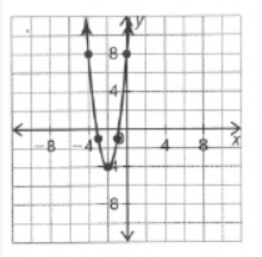
Here we have to find the respective equation of the graph.We will do so by using the straight-line formula which is y=mx+b.
Y is the y-value (distance along the y-axis, which is the vertical axis) and x is the x value (the distance along the x-axis, which is the horizontal axis).
So we can see that our boundary lines are at x=−4 and x=0.So we know that our function will look something like this (notice open and closed endpoints):
f(x)={ …… if x<−4
{ …… if −4≤x<0
{ …… if x≥0
We can pick two points (−4,0) and (−2,0) on the leftmost line to get the equation y=−4x.
We can see that the middle function is y=x2−4 and the rightmost function is just a horizontal line y=2.
So the piece wise function is :
f(x)={ −4x if x<−4
{ x2 if −4≤x<0
{ 0 if x≥0.
The function that represents the equation given in the question is f(x)=
{ −4x if x<−4
{ x2 if −4≤x<0
{ 0 if x≥0.
Page 286 Problem 12 Answer
The given graph in the question is
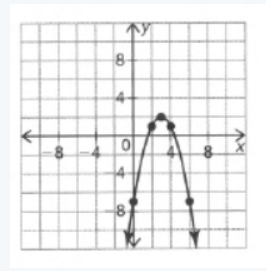
Here we have to find the respective equation of the graph We will do so by using the straight-line formula which is y=mx+b.
Y is the y-value (distance along the y-axis, which is the vertical axis) and x is the x value (the distance along the x-axis, which is the horizontal axis).
So we can see that our boundary lines are at x=2 and x=4.
So we know that our function will look something like this (notice open and closed endpoints):
f(x)={ …… if x<2
{ …… if 2≤x<4
{ …… if x≥4
We can pick two points (0,2) and (2,4) on the leftmost line to get the equation y=2x+4.
We can see that the middle function is y=x2+2 and the rightmost function is just the horizontal line y=2.
So the piecewise function is:
f(x)={ 2x+4 if x<2
{ x2+2 if 2≤x<4
{ 4 if x≥4.
The function that represents the graph in the question is f(x)=
{ 2x+4 if x<2
{ x2+2 if 2≤x<4
{ 4 if x≥4.
Carnegie Learning Skills Practice Exercise 2.3 explained
Carnegie Learning Algebra II Student Skills Practice 1st Edition Chapter 2 Exercise 2.3 Skills Practice Page 286 Problem 13 Answer
The given graph in the question is
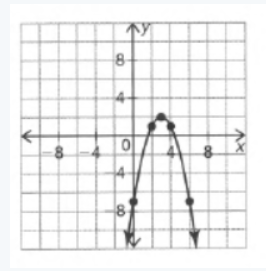
Here we have to find the respective equation of the graph We will do so by using the straight-line formula which is y=mx+b.
Y is the y-value (distance along the y-axis, which is the vertical axis) and x is the x value (the distance along the x-axis, which is the horizontal axis).
So we can see that our boundary lines are at x=2 and x=4.So we know that our function will look something like this (notice open and closed endpoints):
f(x)= { …… if x<2
{ …… if 2≤x<4
{ …… if x≥4
We can pick two points (0,2) and (2,4) on the leftmost line to get the equation y=2x+4.
We can see that the middle function is y=x2+2
and the rightmost function is just the horizontal line y=2.
So the piecewise function is:
f(x)= { 2x+4 if x<2
{ x2+2 if 2≤x<4
{ 4 if x≥4.
The function that represents the graph in the question is f(x)=⎩
{ 2x+4 if x<2
{ x2+2 if 2≤x<4
{ 4 if x≥4.
Page 286 Problem 14 Answer
The given graph in the question is
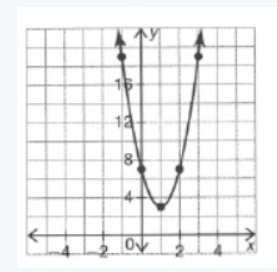
Here we have to find the respective equation of the graph
We will do so by using the straight-line formula which is y=mx+b.
Y is the y-value (distance along the y-axis, which is the vertical axis) and x is the x value (the distance along the x-axis, which is the horizontal axis).
So we see that our boundary lines are x=3 and x=−1.So we know that our function will look something like this(notice open closed endpoints):
f(x)= { …… if x<−1
{ …… if −1≤x<3
{ …… if x≥3
we can pick two points (−1,1) and (0,2) on the leftmost line to get the equation y=−x+3
We can see that the middle function is y=x2−1 and the rightmost function is just the horizontal line y=2
So the piecewise function is:
f(x)= { −x+3 if x<−1
{ x2−1 if −1≤x<3
{ 3 if x≥3
The function that represents the graph given in the question is f(x)=⎩
{ −x+3 if x<−1
{ x2−1 if −1≤x<3
{ 3 if x≥3
Carnegie Learning Algebra II Student Skills Practice 1st Edition Chapter 2 Exercise 2.3 Skills Practice Page 286 Problem 15 Answer
The given graph in the question is
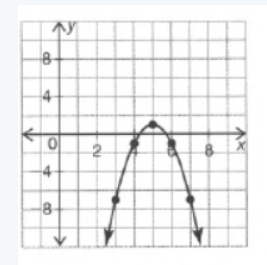
Here we have to find the respective equation of the graph
We will do so by using the straight-line formula which is y=mx+b.
Y is the y-value (distance along the y-axis, which is the vertical axis) and x is the x value (the distance along the x-axis, which is the horizontal axis).
So we can see that our boundary lines are at x=-8 and x=0. So we know that our function will look something like this(notice open and closed endpoints).
f(x)= { …… if x<4
{ …… if 4≤x<6
{ …… if x≥6
We can pick two points (0,4) and (2,6) on the leftmost line to get the equation y=4x+8.
We can see that the middle function is y=x2+4 and the rightmost function is just the horizontal line y=2
So the piece-wise function is
f(x)= { 4x+8 if x<4
{ x2+4 if 4≤x<6
{ 6 if x≥6.
The function that represents the graph given in the question is f(x)=
{ 4x+8 if x<4
{ x2+4 if 4≤x<6
{ 6 if x≥6.
Page 286 Problem 16 Answer
The given graph in the question is

Here we have to find the respective equation of the graph
We will do so by using the straight-line formula which is y=mx+b.
Y is the y value (distance along the y-axis, which is the vertical axis) and x is the x value (the distance along the x-axis, which is the horizontal axis).
So we can see that our boundary lines are at x=-8 and x=0. So we know that our function will look something like this(notice open and closed endpoints).
f(x)= { …… if x<−8
{ …… if −8≤x<0
{ …… if x≥0
We can pick two points (−8,−4)and(−6,0) on the leftmost line to get the equation y=−2x−4
We can see that the middle function is y=x2−2 and the rightmost function is just the horizontal line y=2.
So the piecewise function is
f(x)= { −8x−16 if x<−8
{ x2−8 if −8≤x<0
{0 if x≥0.
The function that represents the graph given in the question is f(x)=
{ −8x−16 if x<−8
{ x2−8 if −8≤x<0
{0 if x≥0.
Chapter 2 Exercise 2.3 Skills Practice guide
Carnegie Learning Algebra II Student Skills Practice 1st Edition Chapter 2 Exercise 2.3 Skills Practice Page 286 Problem 17 Answer
We have to find the function which represents the given graph.
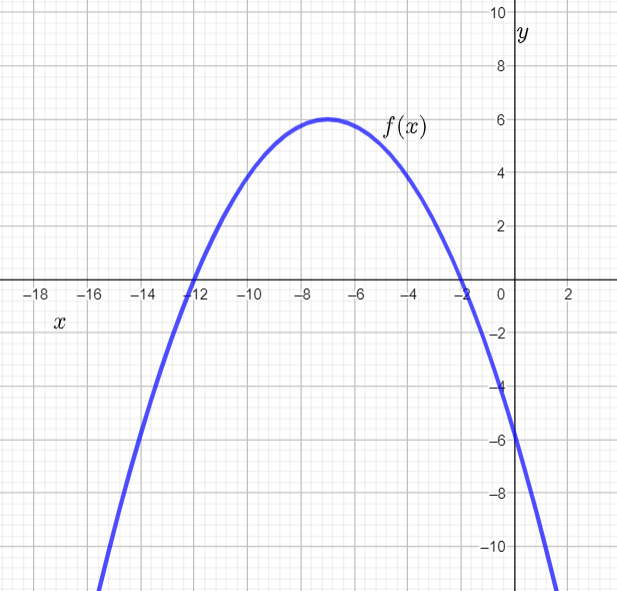
Note that the parabola opens downwards. Hence the general equation of this parabola is y=a(x−h)2+k.
Since the vertex of the parabola is (−7,6) [as marked in figure as A], we get its equation as
y=a(x+7)2+6
Now we have to find the value of a and for that we substitute the value of any point on the parabola to the equation above.
Note that (−2,0) is a point on the parabola and substituting this to the equation we get
0=a(−2+7)2+6
⇒a=−6/52
⇒a=−0.24
Hence the equation of the given graph is
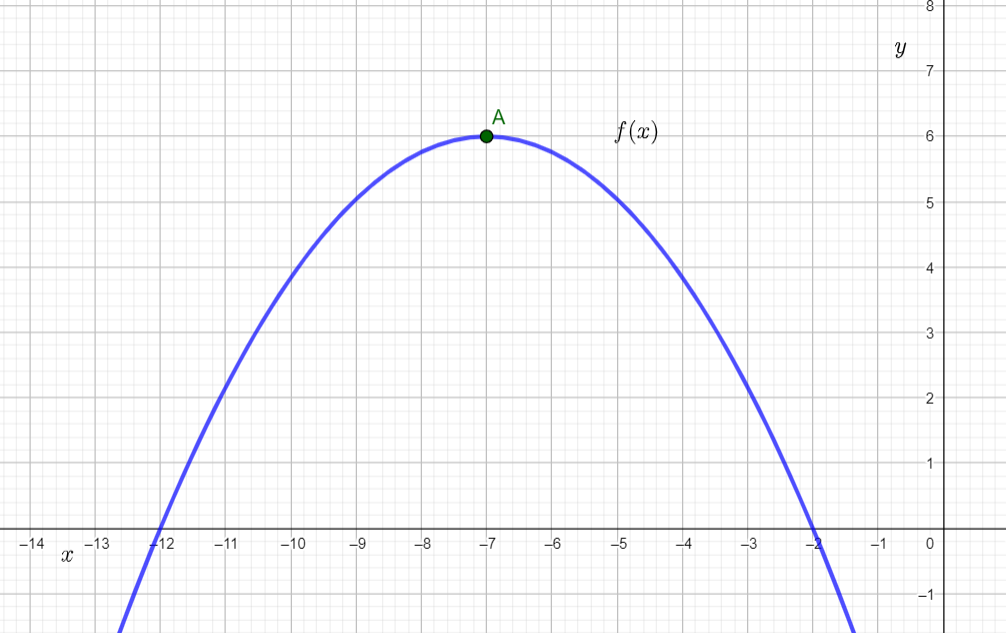
y=−0.24(x+7)2+6
=−0.24(x2+14x+49)+6
=−0.24x2−3.36x−5.76
Thus the function which represents the given graph is y=−0.24x2−3.36x−5.76.
